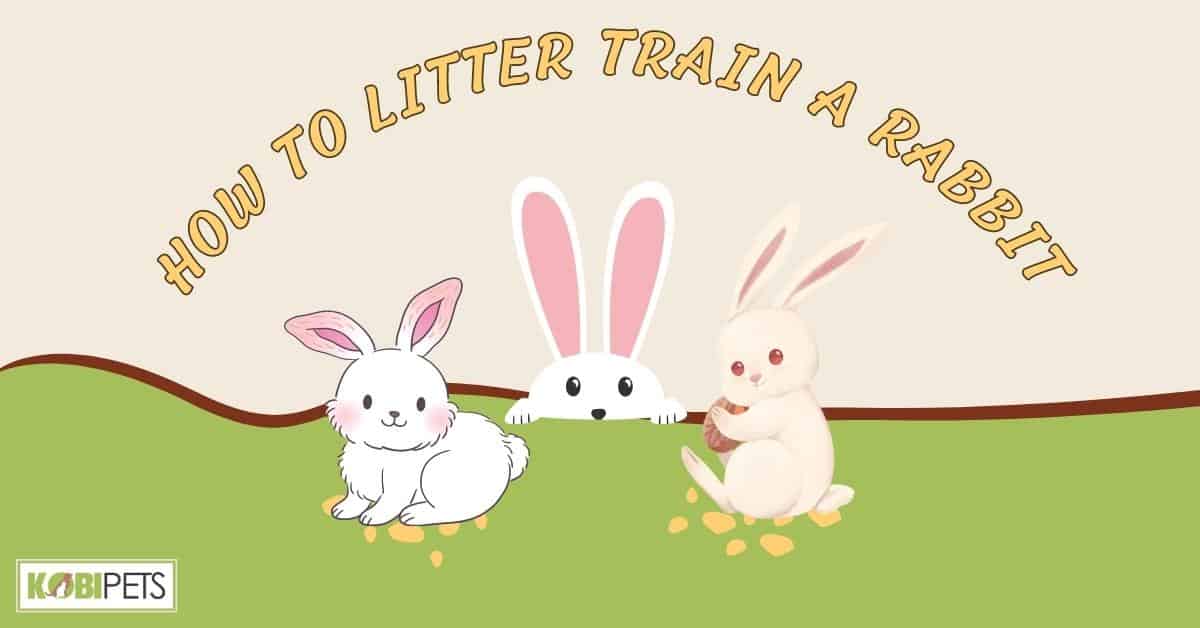
Rabbits are incredibly trainable creatures, and training them can be a great break from the everyday routine for both you and your rabbit.
You can litter train a rabbit by preparing a designated litter box area choosing the right type of litter and offering positive reinforcement, this guide will help you maintain good litter habits for your bunny.
By following the instructions provided in this guide, you will be able to ensure that your house stays clean while also enabling your rabbit to follow its natural urge.
Prepare a Designated Litter Box Area
Preparing a designated litter box area is an important step when it comes to litter training a rabbit. Rabbits are naturally clean animals and will often choose a specific area in their living space for their bathroom needs.
Firstly, it is important to choose the right location for the litter box. Choose a quiet, calm, and secluded area where your rabbit can feel safe and secure while using the litter box.
Rabbits prefer to have a specific area for their litter box that is separate from their living area or sleeping area.
Once you have chosen a location, you can then prepare the designated litter box area.
You will need to place a litter box in the chosen location and then surround it with a barrier or a low fence to prevent the litter from being kicked out of the litter box.
It is also important to choose the right size litter box for your rabbit. The litter box should be big enough for your rabbit to comfortably move around in and have enough room to turn around.
A good size litter box is typically 12×16 inches for smaller rabbits and 16×24 inches for larger rabbits.
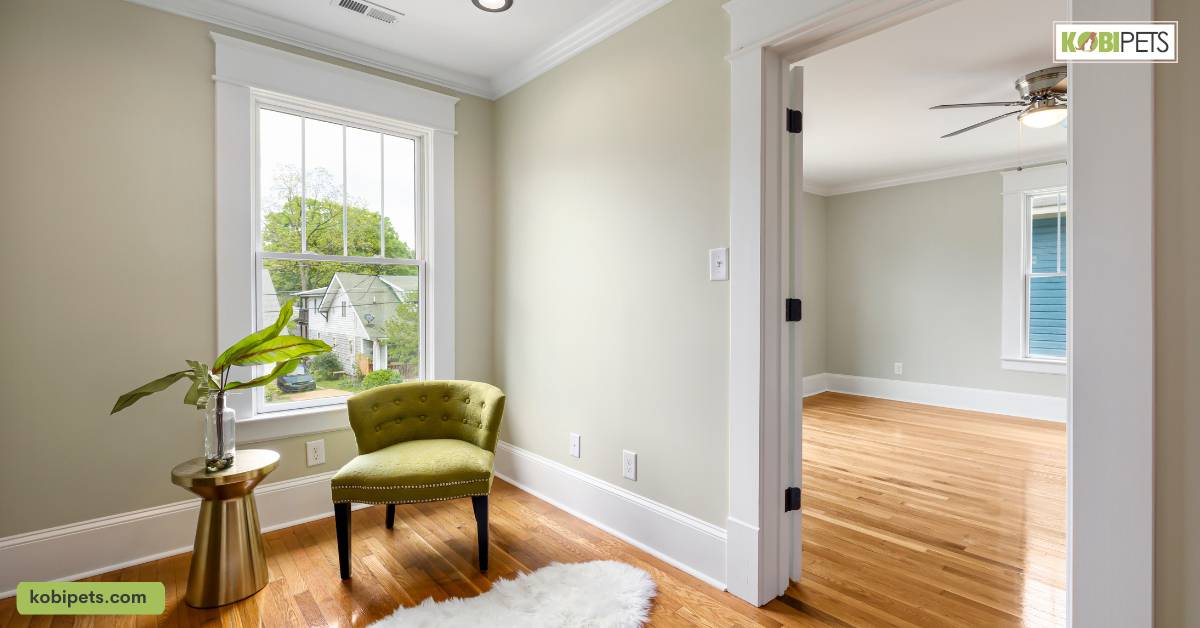
Choose the Right Type of Litter
Choosing the right type of litter is crucial when it comes to litter training a rabbit. The right litter will not only help to absorb moisture and odors but also be safe and healthy for your rabbit. Here are some popular types of litter for rabbits, along with their pros and cons:
| Type of Litter | Pros | Cons |
|---|---|---|
| Wood Shavings | Cheap, absorbent, good odor control | Can be dusty, may contain harmful chemicals, not eco-friendly |
| Paper-Based | Safe and non-toxic, biodegradable, good odor control | Can be expensive, and not as absorbent as other types of litter |
| Corn Cob | Biodegradable, good odor control, dust-free | May attract pests, is not as absorbent as other types of litter, and can be expensive |
| Timothy Hay | Safe and non-toxic, natural, good odor control | Not as absorbent as other types of litter, can be expensive |
| Pellets | Safe and non-toxic, absorbent, good odor control | Can be expensive, and not as soft as other types of litter |
When choosing a litter, it is important to consider the safety and health of your rabbit, as well as the level of absorbency and odor control. Some types of litter may contain harmful chemicals or be too harsh on your rabbit’s sensitive skin.
Paper-based litter is often a safe and non-toxic option, while wood shavings should be avoided due to the potential for harmful chemicals.
Additionally, consider the cost and availability of the litter. Some types of litter may be more expensive than others, while others may be difficult to find in your area.
It is also important to note that some rabbits may have a preference for a certain type of litter, so it may take some trial and error to find the right fit for your bunny.
Introduce the Litter Box to Your Rabbit
If you’re a new rabbit owner, one of the first things you’ll want to do is introduce your furry friend to their litter box. Litter box training your rabbit is an important step in ensuring they have good bathroom habits and can live comfortably indoors.
First, choose a litter box that is appropriate for the size of your rabbit. A basic plastic cat litter pan works well for most rabbits, but there are also larger, corner-shaped litter boxes available that may be more suitable for bigger breeds or multiple rabbits.
Next, place the litter box in a location that is easily accessible to your rabbit and away from their food and water bowls.
Rabbits naturally prefer to use one corner or side of their enclosure as a bathroom area, so observe where your rabbit tends to go and place the litter box accordingly.
Fill the litter box with an appropriate type of litter. Avoid using clumping litters or those made from cedar or pine shavings, as these can be harmful to rabbits if ingested. Instead, opt for paper-based litter or those made from compressed wood pellets.
Finally, encourage your rabbit to use the litter box by placing some of its droppings inside it and rewarding them with treats when they use it correctly. Be patient and consistent with training – it may take some time for your rabbit to get used to using the litter box regularly.
By introducing your rabbit to their litter box early on and providing positive reinforcement during training, you can help ensure that they have good bathroom habits and live happily indoors.
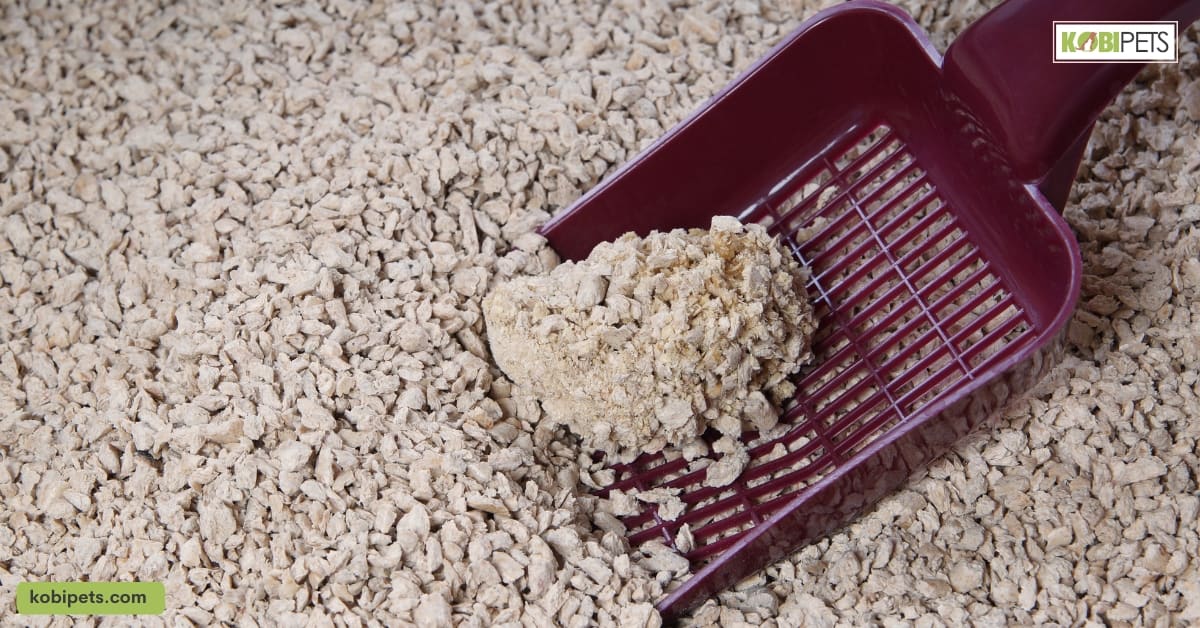
Encourage Your Rabbit to Use the Litter Box
If you’re a rabbit owner, litter training your furry friend is an essential part of their care routine. Not only does it make cleaning up after them easier, but it also helps prevent any unpleasant odors in your home.
- Clean the litter box regularly: Rabbits prefer a clean environment and are more likely to use the litter box if it’s kept clean. Make sure to scoop out any soiled litter daily and replace it with fresh litter.
- Use the right type of litter: Rabbits prefer soft, absorbent materials like paper-based or wood-based litter. Avoid using clumping clay litter as it can be harmful if ingested.
- Place multiple litter boxes around their living space: Rabbits like to have options when it comes to using the bathroom. By placing multiple litter boxes around their living space, you increase the likelihood that they’ll use one of them.
- Reward good behavior: When your rabbit uses the litter box correctly, reward them with a small treat or praise. This positive reinforcement will encourage them to continue using the litter box.
- Limit their space at first: If your rabbit is new to litter training, limit their space by confining them to a smaller area with a puppy pen or other enclosure. This will help them develop good habits and make it easier for you to monitor their progress.
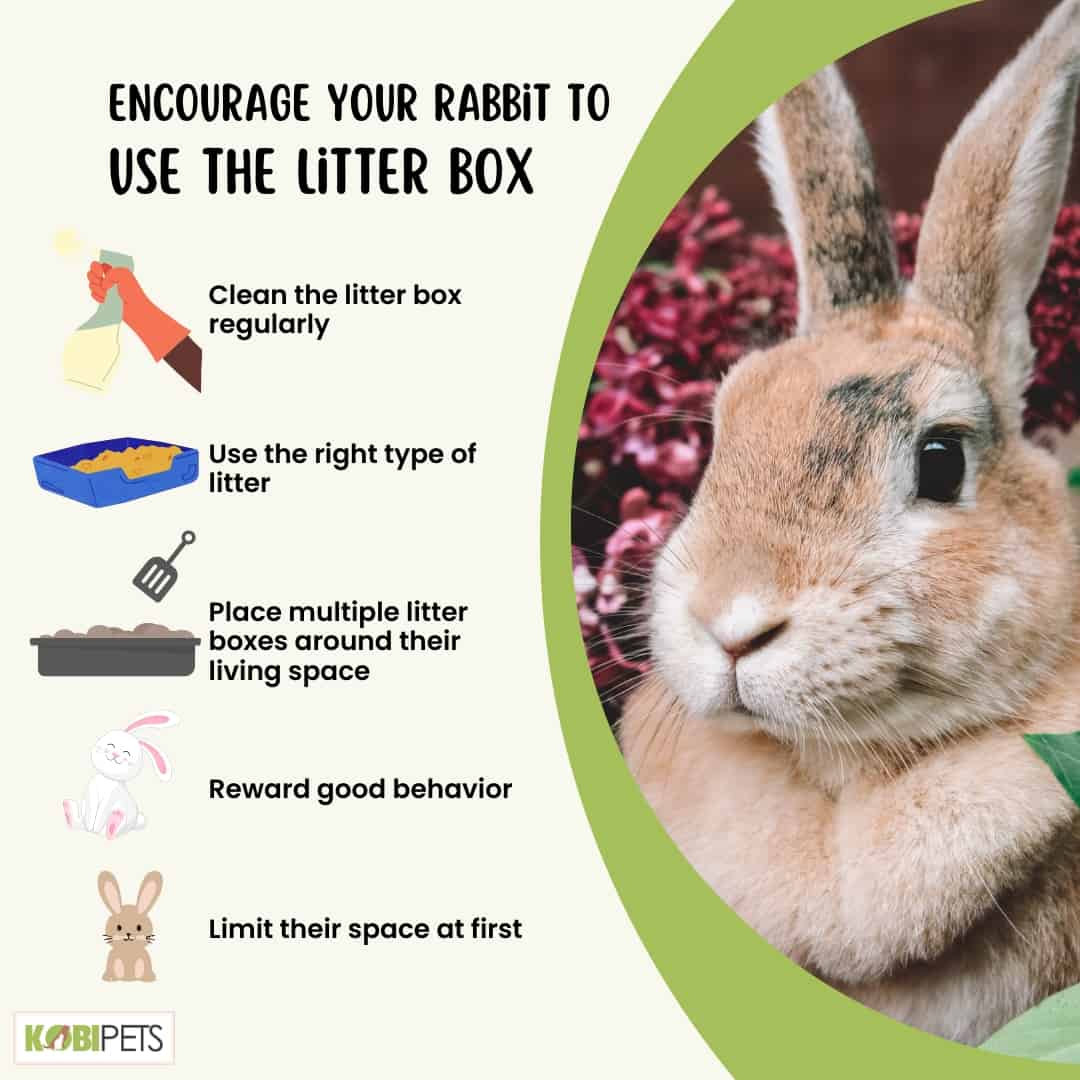
Encourage Your Rabbit to Use the Litter Box
Praise and Reward Your Rabbit for Using the Litter Box
Praising and rewarding your rabbit for using the litter box is an essential part of litter training.
Rabbits respond well to positive reinforcement, and by offering praise and rewards, you can encourage your bunny to consistently use the litter box.
Firstly, it’s important to observe your rabbit’s behavior and recognize when they have used the litter box. When you notice your rabbit using the litter box, offer verbal praise such as “good job” or “well done” in a calm and positive tone.
You can also offer physical affection like gentle petting or a treat.
It’s important to be consistent with your praise and rewards, as this will help your rabbit associate using the litter box with positive reinforcement.
It’s also essential to offer rewards that your rabbit enjoys, such as a small piece of carrot or a favorite toy.
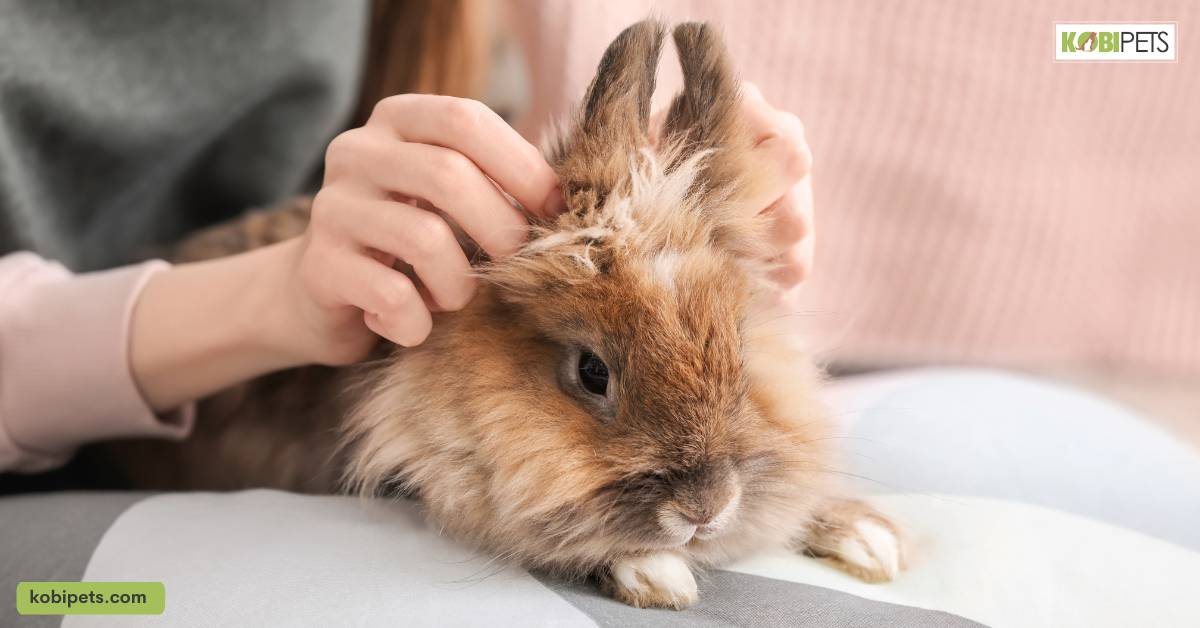
Consistency is Key: Maintaining Good Litter Habits
Litter training your rabbit is a crucial part of their care routine, but it’s not a one-time process. Consistency is key to maintaining good litter habits in your furry friend.
Here are some tips to help you maintain a clean and odor-free environment for both you and your rabbit:
- Stick to a routine: Rabbits thrive on routines, so make sure to stick to a consistent schedule when it comes to cleaning their litter box. Ideally, you should scoop out any soiled litter once or twice daily and replace all the litter once a week.
- Keep an eye on their behavior: If you notice that your rabbit has started going outside of their litter box, it could be a sign that something is wrong. Make sure they have enough space in their living area, check the cleanliness of their litter box, and consider whether there have been any changes in their diet or routine.
- Address any issues promptly: If your rabbit has started going outside of their litter box, address the issue as soon as possible. This could involve making changes to their living space or litter box setup, taking them to the vet if there’s an underlying health issue, or retraining them if necessary.
- Provide plenty of enrichment: Boredom can lead to bad behaviors like going outside of the litter box. Make sure your rabbit has plenty of toys, hiding places, and other forms of enrichment to keep them mentally stimulated and happy.
- Be patient: Litter training takes time and patience – don’t get discouraged if your rabbit doesn’t get it right away! With consistency and positive reinforcement, most rabbits can learn good bathroom habits over time.
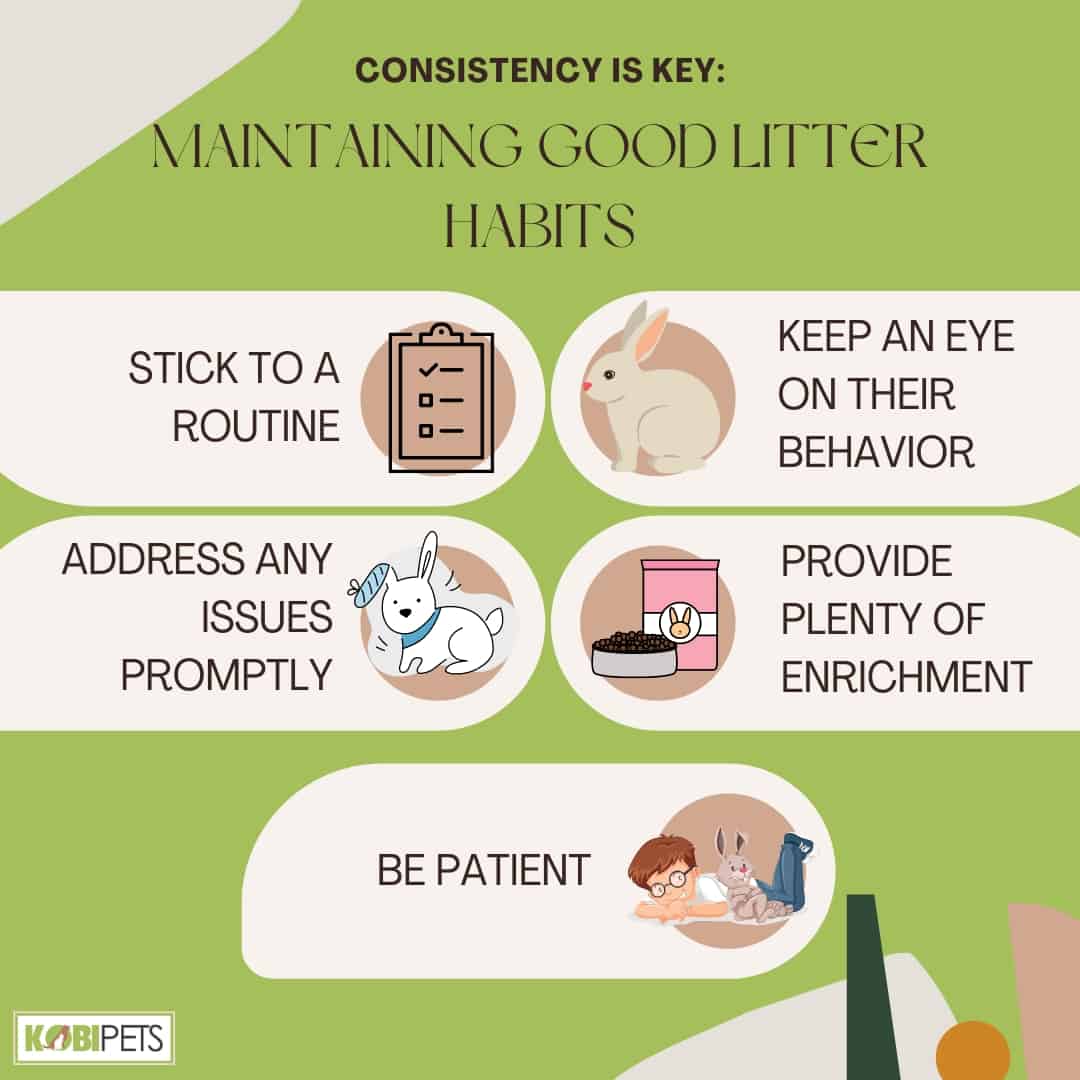
Consistency is Key to Maintaining Good Litter Habits
In conclusion
Once you and your rabbit have gotten into the routine of litter training, there will be less mess to clean up in their cage and you’ll be able to rest easy knowing their area remains spotless.
Not only does this make life much easier for both of you, it also ensures the safety of your bunny by keeping them healthy and safe from foods or materials that could cause harm. Training a rabbit to use the litter box is not always an easy task, but with regular care and patience, they can quickly pick up the habit.






